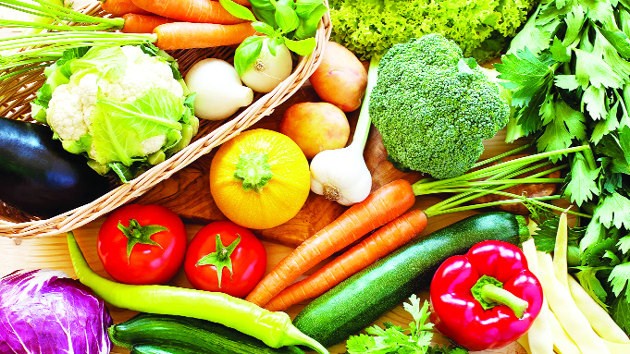Prof Dr R D Gupta
Vegetables constitute the most nutritive portion of our diet. They tone up the energy and vigour and also improve the health. Regular use of vegetables always supply health building and protecting substances such as proteins, carbohydrates, fats and oils, vitamins and minerals. Vegetables contain many metals and non-metals. These metals are not present in free state but are present as salts and complexes. Actually these mineral salts are the constituents of the different tissues of the vegetables.
MINERAL ELEMENTS
At least eleven mineral elements are required for the proper growth and development of the human body. Out of these calcium, phosphorus and iron are required in large quantities which are present in sufficient amount in vegetables. Besides these elements, magnesium, sodium, potassium, sulphur, maganese, copper, iodine and chlorine,are also present in proper amount , which play an important role in keeping us healthy.
Calcium
It is supplied by a number of vegetables but pre- dominates in methi, mustard(sarson), gram leaves, lady finger(bhindi), bitter gourd(karela), sweet potato(shakatr gandhi), cabbage and knol-khol(karam). It is required for keeping bones healthy and for building up resistance to infections. In its absence , the children suffer from many types of diseases like rickets, pigeon chest, irritability and retarded growth. Lack of calcium in the diet may cause trouble in child birth.
Iron
It is found most in gram leaves, methi, sarson and bhindi. Iron is an essential part of the blood and is the oxygen carrier in the body. Most of the iron requirements of the body can be made from green leaves. and the nutritional anaemia can be easily cured by the green leaves.
Phosphorus
It is contained in enough quantities in garlic, gram leaves, kerala, sarson, green chillies, pea, brocolli and cauliflower. Phosphorus is essential for all active tissues of the body. It is required for cell multiplication in both bones and soft tissues, and for the maintenance of proper liquid-content in the tissues. It plays a major role in the oxidation of carbohydrates which liberate energy.
Sulphur
Sulphur is supplied by vegetables like brocolli, radish potato cauliflower, carrot, sweet potato, lettuce tomato and cabbage. The pungency of onions and garlic is due to the compound of sulphur. Sulpur plays a very important role in the protein metabo- lism and particularly in the synthesis of sulphur containing aminoacids. It is, thus evident that the vegetables play a great role in the human diet. They are essential as balanced diet for maintenance of good health.
Magnesium
Magnesium is in abundance in knol-khol, garlic, potato, cabbage, carrof, brocolli, radish sweet potato, tomato and cauliflower. Apart from calcium, bone also contain salts of magnesium metal. Magnesium is also connected with muscular activities and is required for the normal functioning of the nervous system.
Sodium and Potassium
The sodium and potassium is met with in garlic, sweet potato, potato, brocolli, cauliflower, carrot, knol-khol, tomato, radish, cabbage and lettuce though the main source of sodium in our food is common salt (sodium chloride). Sodium, together with other salts, maintains the pressure and equilibrium of blood in body. Lack of sodium in the diet causes loss of apetite, retarded growth, disturbance of the reproductive functions and ultimately death. Although the role of potassiums in general is similar to that of sodium, the function of each is very specific. Potassium is found largely in the body cells (blood cells and muscles) whereas sodium is widely distributed in the body fluid.
Maganese
The content of maganese varies widely. Tomato, lettuce and spinach are rich source for supply of this element. This element is needed for the proper functioning of the vital organs like the kidneys and the liver.
Copper
The richest source of copper is potato and tomato. Copper is also supplied by celery in traces. The chief function of copper in the body is to prevent anaemia. It reinforces the activity of iron in the body.
Chlorine
The rich sources are cabbage, sweet potato, knol-khol, tomato, brocolli, carrot, lettuce, radish, potato and cauliflower. Chlorine is an essential constituent in yielding fluid in the stomach and helps in digestion of the food.
Iodine
It is present the most in bhindi, cabbage and lettuce. Lodine is needed in many tissue activities and prevents goiter (Gillar) in human beings.
(The author is Ex Associate Dean Cum Chief Scientist (KVK), SKUAST-J )


